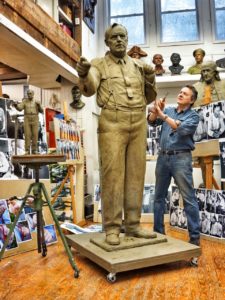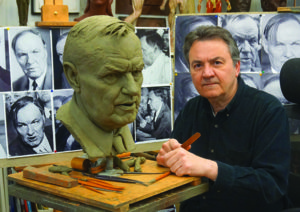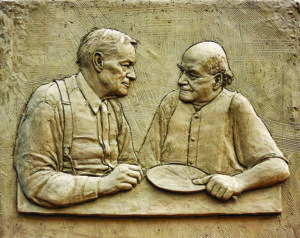Reason in Bronze Clarence Darrow to reunite with William Jennings Bryan at Dayton courthouse

“Can’t you understand? That if you take a law like evolution and you make it a crime to teach it in the public schools, tomorrow you can make it a crime to teach it in the private schools? And tomorrow you may make it a crime to read about it? And soon you may ban books and newspapers. And then you may turn Catholic against Protestant, and Protestant against Protestant, and try to foist your own religion upon the mind of man. If you can do one, you can do the other. Because fanaticism and ignorance is forever busy, and needs feeding. And soon, your Honor, with banners flying and with drums beating we’ll be marching backward, BACKWARD, through the glorious ages of that sixteenth century when bigots burned the man who dared bring enlightenment and intelligence to the human mind!”
—Henry Drummond, the Clarence Darrow character in Inherit the Wind
THE CITY OF DAYTON, which is the county seat of Rhea County, Tennessee, is probably best known as the site of The State of Tennessee v. John Thomas Scopes, commonly known as the Scopes Monkey Trial. The infamous trial took place in the courthouse that still stands today and tackled the question: Should children be permitted to learn about Charles Darwin’s theory of evolution in public school?
Two high-profile lawyers waged this war of words in 1925. William Jennings Bryan insisted the Bible story of creation was the only story to be taught to school children in their study of the natural world. On the other side, Clarence Darrow defended the right of a young teacher named John T. Scopes to teach evolutionary theory to his pupils. In this very Christian community in 1925, when there actually was a law on the books prohibiting public school teachers from denying the biblical account of human origins, one of the great debates of the twentieth century took central stage and captured the national zeitgeist.
Nearly eighty years after the famous trial, the board of trustees of Bryan College (located in Dayton) commissioned Chattanooga artist Cessna Decosimo to create a life-sized bronze statue of Bryan in honor of the school’s seventy-fifth anniversary. Because three statues depicting Bryan at an older age already existed in various locations in the United States, Decosimo decided to depict Bryan in his prime for the Rhea County Courthouse lawn.
 It wasn’t long before this lone statue, representing only one half of the actual history of the Scopes trial, came to the attention of American Humanist Association member William Dusenberry, who conceived of adding a Darrow statue while traveling in Dayton in 2009. He contacted the Dayton Chamber of Commerce and was told it might be possible, but he abandoned the idea when he couldn’t generate enough interest in funding it. Dusenberry’s enthusiasm for the Darrow sculpture was renewed after seeing a 2014 Humanist magazine piece featuring an artwork titled “Knowledge is Power” by sculptor Zenos Frudakis that depicts famous thinkers, including Charles Darwin. Frudakis is well known for his award-winning bronze sculptures, commissioned for both public and private display, including historical and contemporary figures and more conceptual works like his famous “Freedom” sculpture in Philadelphia.
It wasn’t long before this lone statue, representing only one half of the actual history of the Scopes trial, came to the attention of American Humanist Association member William Dusenberry, who conceived of adding a Darrow statue while traveling in Dayton in 2009. He contacted the Dayton Chamber of Commerce and was told it might be possible, but he abandoned the idea when he couldn’t generate enough interest in funding it. Dusenberry’s enthusiasm for the Darrow sculpture was renewed after seeing a 2014 Humanist magazine piece featuring an artwork titled “Knowledge is Power” by sculptor Zenos Frudakis that depicts famous thinkers, including Charles Darwin. Frudakis is well known for his award-winning bronze sculptures, commissioned for both public and private display, including historical and contemporary figures and more conceptual works like his famous “Freedom” sculpture in Philadelphia.
When the Darrow sculpture was proposed to Frudakis, it immediately felt right. He has an affinity for Darwin and a desire to effect social change and promote truth through his artistic work. He also recalled when he was twelve playing the part of the young schoolboy in a production of Inherit the Wind, the 1955 play based on the Scopes trial and later adapted as a film starring Spencer Tracy as the Darrow character and Fredric March as the lawyer based on Bryan.
Frudakis remembers one of his character’s lines still: “You was a worm once.” To create a statue of Clarence Darrow to be placed on the courthouse lawn across from William Jennings Bryan was a way for Frudakis to complete the history. It was a labor of love.
To fund the statue, Frudakis and his business partner Rosalie Frudakis solicited the help of secular groups like the American Humanist Association and the Freedom From Religion Foundation, with a majority of the funding coming from FFRF members. One of the sculptor’s favorite donations came from a woman who as a young child accompanied her father, the publicist for Inherit the Wind, to the 1960 film premiere in Dayton, where she remembers meeting the famous defendant, John T. Scopes.
Sculpture is a whole mind, body, and heart activity for Frudakis. He visited the Dayton courthouse numerous times, dressed up as the real Darrow did in red suspenders and ill-fitting pants, and followed classes of school children visiting the Scopes Trial Museum to explain to them the rest of the story. Committed to the truth of the statue he’s creating, his Darrow looks sixty-eight (the lawyer’s age during the trial) and a bit rumpled. And he appears jacketless, just as he was in that hot, non-air-conditioned Tennessee courtroom in 1925.
Frudakis has also created a bronze relief for the back of the statue’s base that depicts Darrow and Bryan engaging each other thoughtfully. “I think it’s a good addition as it shows the professional camaraderie and rapport between the two attorneys in the case,” the sculptor explains. “It also shows Bryan at an accurate age, sixty-five, for the trial.”
 The dedication ceremony for the Darrow statue will take place on July 14, 2017, in Dayton and could see some fireworks between the supporters of the new statue and at least one vehement detractor, a pastor of the American Bible Protestant Church. Frudakis wishes for the dedication to be sensitive to the community in which the statue is being installed and hopes for a peaceful and harmonious event.
The dedication ceremony for the Darrow statue will take place on July 14, 2017, in Dayton and could see some fireworks between the supporters of the new statue and at least one vehement detractor, a pastor of the American Bible Protestant Church. Frudakis wishes for the dedication to be sensitive to the community in which the statue is being installed and hopes for a peaceful and harmonious event.
“This is a time when we need a voice of reason more than ever,” says the sculptor. “We need the voice embodied in bronze, because bronze lasts forever unlike most things.”
As this was written, Darrow’s body was at the foundry while his head was still in the Frudakis’s Philadelphia studio. By the day of dedication, head and body will be one, set on the courthouse lawn across from Bryan. There the two famous attorneys will stand facing each other, engaged in a debate of tradition and ideology versus knowledge and progress. How appropriate for this history to be revived at a time when so much remains in contention.
